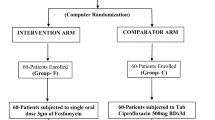Summary
20 urologists took part in a single blind, randomized study. Female patients with acute uncomplicated UTI were recruited. The patients received either a single dose of 3 g fosfomycin trometamol versus 200 mg ofloxacin or 1.92 g cotrimoxazole. Follow-up examinations were carried out after one and four weeks. Of 562 patients 446 could be evaluated for efficacy and 496 for tolerance. Patients were analysed according to the amount of bacteriuria: “significant” (≥ 105/ml), “low count” (102–104 ml) and “no bacteriuria” (≤ 101/ml), as well as according to the sensitivity of the infecting organisms: sensitive (resistant): fosfomycin trometamol ≤ 16 mg/l (≥ 128 mg/l), ofloxacin ≤ 1 mg/l (≥ 8 mg/l), co-trimoxazole ≤ 2/38 mg/l (≥ 16/304 mg/l). Up to one week the following results could be achieved: clinical improvement was attained in patients with “significant” bacteriuria (fosfomycin trometamol-150, ofloxacin-89, co-trimoxazole -69) in 94.7% for fosfomycin trometamol, in 95.4% for ofloxacin, and in 94% for co-trimoxazole; in patients with “low count” bacteriuria (fosfomycin trometamol-44, ofloxacin-18, co-trimoxazole-30) in 95.2% for fosfomycin trometamol, in 93.7% for ofloxacin, and in 96.4% for co-trimoxazole; and in patients with no bacteriuria (fosfomycin trometamol-11, ofloxacin-6, co-trimoxazole-4) in 81.8% for fosfomycin trometamol, in 100% for ofloxacin and in 100% for co-trimoxazole. Sterile urine or non-significant bacteriuria was achieved in the group with “significant” bacteriuria in 87.4% for fosfomycin trometamol, in 91% for ofloxacin and in 88.4% for co-trimoxazole; and in the group with “low count” bacteriuria in 86.4% for fosfomycin trometamol, in 94.4% for ofloxacin, and in 96.7% for cotrimoxazole. In patients infected by resistant (intermediary sensitive) strains sterile urine or non-significant bacteriuria could be achieved in 7/11 (5/6) patients for fosfomycin trometamol and 2/5 (0/1) for co-trimoxazole. Concerning side effects a total of 6.8% for fosfomycin trometamol, 5.9% for ofloxacin and 7.9% for co-trimoxazole was experienced mostly at the gastrointestinal site (fosfomycin trometamol-6.4%, ofloxacin-5.9%, co-trimoxazole-6.3%). This study demonstrates that fosfomycin trometamol was equally effective and tolerable in single-dose therapy of acute uncomplicated UTI in females when compared to other established drugs such as ofloxacin and co-trimoxazole.
Zusammenfassung
In einer einfach blinden randomisierten Studie, an der sich 20 Urologen beteiligten, wurden Frauen mit akuten unkomplizierten Harnwegsinfektionen aufgenommen. Die Patientinnen erhielten eine Einmaltherapie mit 3 g Fosfomycin Trometamol im Vergleich zu 200 mg Ofloxacin oder 1,92 g Co-trimoxazol. Die Nachuntersuchungen erfolgten nach einer Woche und nach vier Wochen. Von 562 Patientinnen konnten 446 hinsichtlich der Wirksamkeit und 496 hinsichtlich der Verträglichkeit ausgewertet werden. Die Analyse der Patientinnen erfolgte entsprechend der Erregerzahl im Urin vor Therapiebeginn: „signifikante“ (≥ 105/ml), „niedrige“ (102–104/ml) und „keine“ ≤ 101/ml) Bakteriurie — und entsprechend der Erregerempfindlichkeit: sensibel (resistent): Fosfomycin Trometamol ≤ 16 mg/l (≥ 128 mg/l), Ofloxacin ≤ 1 mg/l (≥ 8 mg/l), Co-trimoxazol ≤ 2/38 mg/l (≥ 16/304 mg/l). Bis zu einer Woche nach der Therapie wurden folgende Ergebnisse erzielt: Bei Patientinnen mit „signifikanter“ Bakteriurie (Fosfomycin Trometamol-150, Ofloxacin-89, Co-trimoxazol-69) ergab sich eine klinische Heilung bzw. Besserung nach Fosfomycin Trometamol in 94,7%, nach Ofloxacin in 95,4% und nach Cotrimoxazol in 94,0% der Patientinnen. Bei Patientinnen mit „niedriger“ Bakteriurie (Fosfomycin Trometamol-44, Ofloxacin-18, Cotrimoxazol-30) wurden nach Fosfomycin Trometamol 95,2%, nach Ofloxacin 93,7% und nach Co-trimoxazol 96,4% der Patientinnen geheilt bzw. gebessert. Bei Patientinnen ohne Bakteriurie (Fosfomycin Trometamol-11, Ofloxacin-6, Co-trimoxazol-4) betrug die Heilungs- bzw. Besserungsrate nach Fosfomycin Trometamol 81,8%, nach Ofloxacin 100% und nach Co-trimoxazol 100%. Steriler Urin bzw. eine nicht signifikante Bakteriurie wurde in den Gruppen mit „signifikanter“ Bakteriurie nach Fosfomycin Trometamol in 87,4%, nach Ofloxacin in 91,0% und nach Co-trimoxazol in 88,4% und in den Gruppen mit „niedriger“ Bakteriurie nach Fosfomycin Trometamol in 86,4%, nach Ofloxacin in 94,4% und nach Co-trimoxazol in 96,7% der Patientinnen erreicht. Bei Patientinnen mit Harnwegsinfektionen, verursacht durch resistente (mäßig empfindliche) Erreger, konnte ein steriler Urin bzw. eine nicht signifikante Bakteriurie nach Fosfomycin Trometamol bei 7/11 (5/6) und nach Co-trimoxazol bei 2/5 (0/1) der Patientinnen erreicht werden. Insgesamt wurden nach Fosfomycin Trometamol bei 6,8%, nach Ofloxacin bei 5,9% und nach Co-trimoxazol bei 7,9% der Patientinnen Nebenwirkungen beobachtet, die meistens Magen-Darmstörungen entsprachen (nach Fosfomycin Trometamol bei 6,4%, nach Ofloxacin bei 5,9% und nach Co-trimoxazol bei 6,3% der Patientinnen). Diese Studie zeigt, daß Fosfomycin Trometamol bei der Einmaltherapie akuter unkomplizierter Harnwegsinfektionen bei Frauen genauso wirksam und verträglich wie Ofloxacin und Co-trimoxazol ist.
Similar content being viewed by others
References
Bailey, R. R. Single-dose therapy of urinary tract infection. 1st ed. ADIS Health Sciences Press, Sydney 1983, pp. 1–125.
Grüneberg, R. N., Brumfitt, W. Single dose treatment of acute urinary tract infection. Brit. Med. J. 3 (1967) 649–651.
Rubin, R. H., Fang, L. S. T., Jones, S. R., Munford, R. S., Slepack, J. M., Varga, P. A. et al.: Single-dose amoxicillin therapy for urinary tract infection. J. Amer. Med. Ass. 244 (1980) 561–564.
Greenwood, D. The trometamol salt of fosfomycin: microbiological evaluation. Eur. Urology 13 (Suppl. 1) (1987) 69–75.
Bergogne-Bérézin, E., Muller-Servieys, C., Joly-Guillon, M. L., Dronne, N. Trometamol-fosfomycin (Monuril) bioavailability and food-drug interaction. Eur. Urology 13 (Suppl. 1) (1987) 64–68.
Naumann, G., Nimmich, W., Budde, E., Straube, E. Zur Methodik des Nachweises antikörperbeladener Bakterien im Urin. Dtsch. med. Wschr. 106 (1981) 1418–1419.
Author information
Authors and Affiliations
Rights and permissions
About this article
Cite this article
Naber, K.G., Thyroff-Friesinger, U. Fosfomycin trometamol versus ofloxacin/Co-trimoxazole as single dose therapy of acute uncomplicated urinary tract infection in females: A multicentre study. Infection 18 (Suppl 2), S70–S76 (1990). https://doi.org/10.1007/BF01643431
Issue Date:
DOI: https://doi.org/10.1007/BF01643431




